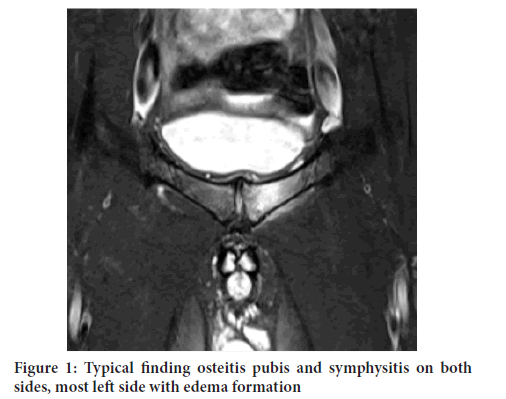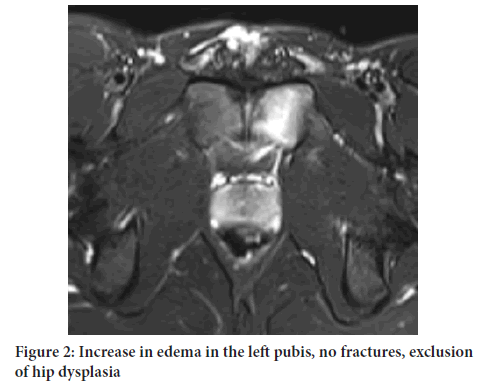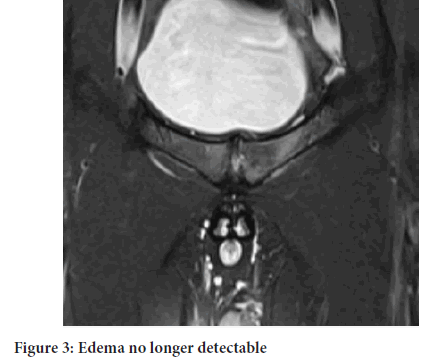Case Report - (2023) Volume 14, Issue 4
Abstract
When diagnosing a long-lasting pubic osteitis, a multimodal therapy regimen is necessary. Even if the symptoms of osteitis are still minor, therapy should start immediately to avoid chronification. This includes laboratory control (inflammation parameters, vitamin D) and immediate start with an integrative approach. The treatment regimen is based on the individual symptoms and should frequently be checked in clinical examinations and adjusted if necessary. This also includes the use of multicomponent drugs such as Traumeel and Lymphomyosot. They should be administered orally and also by means of injections under consideration of doping regulations, accompanied by ESWT (Extracorporeal Shock Wave Therapy) twice a week as well as physiotherapy and self-exercise.
Keywords
Chronic osteitis, Multimodal treatment, Groin pain
Introduction
Groin pain in athletes is often caused by osteitis pubis which has an incidence of 0.5%-8% in athletes (Via, et al., 2019). The incidence in long distance runners and kicking sports is especially high. An imbalance between abdominal and hip muscles is being discussed as a cause of chronic pubic inflammation, resulting in repetitive microtrauma. Osteitis pubis often results in long absences from training and competition which is especially inapt in high level athletes. Different treatment options are available, mostly multimodal therapies, conservative as well as surgical options. This case report describes diagnosis, individualized therapeutic management and return to sports in a professional soccer athlete with chronic pubic inflammation on both sides.
Case Presentation
A 31-year-old licensed footballer (8 years 1st Bundesliga, 2 years 3rd division) presents himself in a sports medicine practice on June 24th 2021 with chronic groin pain. He reports that the symptoms lasted over a period of 4 months. He hardly had any major injuries or overuse damage in the past. He returned to team training in May 2021 after a corona-related pause in training and competitions and immediately suffered from pubic pain on both sides. Soccer training was hardly possible due to the pain.
Past medical history
There was a treatment period from May 2021 to the end of June 2021 away from home without any significant improvement. According to the patient, conservative treatment consisted of physiotherapy by the club’s own physiotherapists, NSAIDs (Diclofenac) orally two times daily and one local injection of corticosteroids at the end of May at the beginning of treatment. Since there was no pain relief the athlete had a complete sports break until the end of June 2021 (Table 1).
| Time-line | Therapy regime |
|---|---|
| 01-07-2021 | Second local injection-Traumeel (2 ampoules) and Lymphomyosot (1 ampoule) |
| 05-07-2021 | Slight symptom relief and less stretch pain. |
| Adaptation of the therapy regime- •Inclusion of pain-free MTT, also continuation of ESWT and medication. •Third local injection-Traumeel (2 ampoules) and Lymphomyosot (1 ampoule) |
|
| 15-07-2021 | Fourth local injection-Traumeel (2 ampoules) and Lymphomyosot (1 ampoule) |
| 30-07-2021 | No clinical signs of symphysitis. |
| Adaptation of the therapy regime- • Start of HIIT, reduction of medications-Only Traumeel 2 × 1 tablet daily. No more • ESWT. • Fifth local injection-Traumeel and Lymphomyosot |
|
| 26-08-2021 | Return to sports-Start of team training with individual increase in load after a medical check with a trainer. |
| 04-09-2021 | First soccer game (20 minutes). After that he played on a regular basis again |
Table 1: Therapy regime from July 1st, 2021 to September 4th, 2021.
Start of treatment at surgery and sports medicine practice on June 24th, 2021
The main symptoms at the first clinical examination were: Pressure pain in the pubic branch area and increased stretching pain on the left side. The adductor longus tendon is painful to stretch on both sides; also stinging pain occurs related to movement. Cycling activities were almost painless, but the athlete felt constant everyday pain with low stress.
Diagnostic tests
• Sonography of the inguinal region lead to exclusion of inguinal hernia while no signs of lymph node swellings were detectable.
• Laboratory tests revealed a vitamin D deficiency but no relevant pathological findings in inflammation markers, electrolytes, uric acid and iron load (Table 2).
| Type | Value | Unit |
|---|---|---|
| 25(OH)D (25-hydroxyvitamin D) | 13.6 | μg/L |
| CRP (C-reactive protein) | 0.2 | mg/dL |
Table 2: Diagnostic tests and their results.
• High resolution MRI on May 25th, 2021 after detailed clinical examination revealed the typical finding of osteitis pubis and symphysitis on both sides with edema formation in the left pubis (Figure 1). Fractures and hip dysplasia could be excluded (Figures 2 and 3).
Figure 1: Typical finding osteitis pubis and symphysitis on both sides, most left side with edema formation
Figure 2: Increase in edema in the left pubis, no fractures, exclusion of hip dysplasia
Figure 3: Edema no longer detectable
Therapy regime from June 24th, 2021 onwards
Taking into account the previous unsuccessful therapy we started ESWT therapy (pubic bone /adductors) twice a week by a doctor, also ESWT therapy lumbar spine paravertebral 3 times a week by medically trained specialists. We also performed cryotherapy locally on both sides with a cryogenic device, applied by medical specialists according to medical instructions, once daily. Osteopathy by trained osteopaths and physiotherapists after consultation with a doctor and drawing up a therapy plan. Massage therapy was not permitted, so as not to aggravate local inflammatory stimuli. The patient did core stability exercises on his own and under physiotherapeutic guidance.
Oral medication
• Traumeel 3 × 5 tablets daily initially. From the 5th day on 3 × 2 tablets.
• Oral enzyme combination 3 × 2 capsules daily
• Lymphomyosot 3 × 1 tablet daily
• Vitamin D and K2 administration (4000 IU daily)
• Vitamin E high dose 40-50 IU daily
• No use of NSAIDs.
• Basica for deacidification (2 × 3 tablets with plenty of water)
Local injection 1 time (×) a week: 2 ampoules Traumeel and 1 ampoule Lymphomyosot injection solution were injected directly near the painful point-06/24/2021, 07/01/2021, 07/05/2021, 07/15/2021, 07/30/2021 (5 times in total).
Nourishment: The athlete was educated about an anti-inflammatory diet in the sense of a largely vegetarian diet and motivated to change his eating habits to an alkaline nutrition based on the ORAC (Oxygen Radical Absorbance Capacity) list. Thus, the guiding principle for a therapy-accompanying diet applies-“Much that grows in the earth, little that runs on the earth”.
Medical check-up after 10 days on July 5th, 2021: The athlete reports a slight symptom relief and an improved pain on stretching.
Adaptation of the therapy regime on July 5th, 2021: We then adapted the therapy regime with promotion of physiotherapy with the inclusion of pain-free MTT (medical training therapy), also continuation of ESWT and medication as described.
Medical check-up after 4 weeks July 30th, 2021: The athlete reports significantly subsided pain during guided MTT. Clinical evaluation reveals that typical signs of symphysitis can no longer be clinically triggered.
Adaptation of the therapy regime on July 30th, 2021: Start of HIIT (High Intensity Interval Training), reduction of medications-Only Traumeel 2 × 1 tablet daily, no more ESWT.
Medical check-up after 8 weeks with MRI 08/26/2021
Adjustment of therapy regime on 08/26/2021: Return to sports: Start of team training with individual increase in load after a medical check- up with a trainer. The patient is deployed for the first time in a soccer-game (20 minutes after substitution) on September 4th, 2021. After that he played on a regular basis again. During the course a video-controlled treadmill analysis was performed and an adjustment of insoles for football boots was made.
Follow-up examination in mid-September 2021: Total relief of symptoms, no groin pain was observed.
Discussion
In the case of a chronically imposing pubic osteitis with the corresponding symptoms, holistic, integrative therapy is necessary for permanent healing. The interaction of local and systemic anti-inflammatory therapy in com-bination with ESWT is necessary to achieve therapeutic success. The previous therapeutic approaches that did not gain pain relief had to be adapted here. However, a high level of patient adherence to the whole therapeutic and rehabilitation plan is also necessary. Here, the patient should change the exercise program as well as his eating habits. Based on the inflammatory effects of arachidonic acid e.g. contained in pork and beef. Arachidonic acid from animal food plays a key role in the formation of inflammatory messenger substances such as prostaglandins and leukotrienes. These fire up inflammatory processes in the body and thus promote swelling, overheating and also pain and movement restrictions in joints, tendons and muscles (Kim J and Lee J, 2014; Adam O, et al., 2003). In the end of June 2021 the patient was already treated with a long-term therapy with NSAIDs without relevant pain relief. Since NSAIDs have been described to be able to impair tendon-to-bone healing processes (Cohen DB, et al., 2006) it is necessary to also have different treatment options, such as multicomponent drugs that are able to modulate inflammation. Traumeel was evaluated in a preclinical setting to have a positive impact on the resolution of inflammatory processes (Jordan PM, et al., 2021) and also shown efficacy in several clinical trials (Schneider C, 2011; Lozada CJ, et al., 2017). Lymphomyosot has been shown to improve the healing process and lymph edema in a mouse model (Keim AP, et al., 2013). It is especially important, that the drugs are in-line with doping regulations (https://www.nada.de/ medizin/nadamed). ESWT has also been shown to have clinical benefits in the treatment of groin pain (Schöberl M, et al., 2017). The case study shows the need for a complex, individually designed integrative therapeutic concept for the pubic osteitis.
With the exception of the magnetic resonance imaging check-up, the success of the therapy can only be checked clinically on the basis of the anamnesis and examination and thus of course depends on the compliance of the patient and the experience of the examiner. Here, valid and objectifiable test results for checking the subjective perception of the patient would be desirable.
Patient’s perspective
At the end of June the professional athlete was very pessimistic about his rehabilitation, because the former treatment period did not show any improvement or pain relief. About ten days after changing the treatment paradigm the athletes’ mood improved significantly as there were first signs of pain reduction. Also, in the second Bundesliga, players that are not ready for play have less income, so that musculosceletal disorders do have a direct impact on the financial situation.
Conclusion
The chronic osteitis pubis represents a challenge for the sports physician, the athlete and the medical team due to the often long-lasting symptoms. A multimodal, integrative treatment that includes many parameters such as nutrition, injections, shock wave therapy and the accompanying physiotherapy is necessary for a quick and sustainable return to sports. It is also important to inform the patient about an adapted alkaline-oriented diet and to consult the team of trainers about the dosage of the training to ensure an optimal return to sports.
Acknowledgement
Thanks for the support of the practice team as well as physiotherapy team and Heel medical staff for technical support in the publication process.
References
- Via AG, Frizziero A, Finotti P, Oliva F, Randelli F, Maffulli N. Management of osteitis pubis in athletes: Rehabilitation and return to training-a review of the most recent literature. Open Access J Sports Med. 2018: 1-10.
[Crossref] [Google scholar] [Pubmed]
- Kim J, Lee J. A review of nutritional intervention on delayed onset muscle soreness. Part I. J Exerc Rehabil. 2014; 10(6): 349.
[Crossref] [Google scholar] [Pubmed]
- Adam O, Beringer C, Kless T, Lemmen C, Adam A, Wiseman M, et al. Anti-inflammatory effects of a low arachidonic acid diet and fish oil in patients with rheumatoid arthritis. Rheumatol Int. 2003; 23: 27-36.
[Crossref] [Google scholar] [Pubmed]
- Cohen DB, Kawamura S, Ehteshami JR, Rodeo SA. Indomethacin and celecoxib impair rotator cuff tendon-to-bone healing. Am J Sports Med. 2006; 34(3): 362-329.
[Crossref] [Google scholar] [Pubmed]
- Jordan PM, van Goethem E, Müller AM, Hemmer K, Gavioli V, Baillif V, et al. The Natural Combination Medicine Traumeel (Tr14) improves resolution of inflammation by promoting the biosynthesis of specialized pro-resolving mediators. Pharmaceuticals. 2021; 14(11): 1123.
[Crossref] [Google scholar] [Pubmed]
- Schneider C. Traumeel-an emerging option to non-steroidal anti-inflammatory drugs in the management of acute musculoskeletal injuries. Int J Gen Med. 2011: 225-234.
[Crossref] [Google scholar] [Pubmed]
- Lozada CJ, del Rio E, Reitberg DP, Smith RA, Kahn CB, Moskowitz RW. A double-blind, randomized, saline-controlled study of the efficacy and safety of co-administered intra-articular injections of Tr14 and Ze14 for treatment of painful osteoarthritis of the knee: The MOZArT trial. European Journal of Integrative Medicine. 2017; 13: 54-63.
[Crossref] [Google scholar] [Pubmed]
- Keim AP, Slis JR, Mendez U, Stroup EM, Burmeister Y, Tsolaki N, et al. The multicomponent medication lymphomyosot improves the outcome of experimental lymphedema. Lymphat Res Biol. 2013; 11(2): 81-92.
[Crossref] [Google scholar] [Pubmed]
- Schöberl M, Prantl L, Loose O, Zellner J, Angele P, Zeman F, et al. Non-surgical treatment of pubic overload and groin pain in amateur football players: A prospective double-blinded randomised controlled study. Knee Surg Sports Traumatol Arthrosc. 2017; 25: 1958-1966.
[Crossref] [Google scholar] [Pubmed]
Author Info
Stefan Dr. Pecher*Citation: Pecher SD: Chronic Osteitis Pubis on Both Sides-with Holistic Treatment for Quick Healing
Received: 20-Mar-2023 Accepted: 04-Apr-2023 Published: 11-Apr-2023, DOI: 10.31858/0975-8453.14.4.245-247
Copyright: This is an open access article distributed under the terms of the Creative Commons Attribution License, which permits unrestricted use, distribution, and reproduction in any medium, provided the original work is properly cited.
ARTICLE TOOLS
- Dental Development between Assisted Reproductive Therapy (Art) and Natural Conceived Children: A Comparative Pilot Study Norzaiti Mohd Kenali, Naimah Hasanah Mohd Fathil, Norbasyirah Bohari, Ahmad Faisal Ismail, Roszaman Ramli SRP. 2020; 11(1): 01-06 » doi: 10.5530/srp.2020.1.01
- Psychometric properties of the World Health Organization Quality of life instrument, short form: Validity in the Vietnamese healthcare context Trung Quang Vo*, Bao Tran Thuy Tran, Ngan Thuy Nguyen, Tram ThiHuyen Nguyen, Thuy Phan Chung Tran SRP. 2020; 11(1): 14-22 » doi: 10.5530/srp.2019.1.3
- A Review of Pharmacoeconomics: the key to “Healthcare for All” Hasamnis AA, Patil SS, Shaik Imam, Narendiran K SRP. 2019; 10(1): s40-s42 » doi: 10.5530/srp.2019.1s.21
- Deuterium Depleted Water as an Adjuvant in Treatment of Cancer Anton Syroeshkin, Olga Levitskaya, Elena Uspenskaya, Tatiana Pleteneva, Daria Romaykina, Daria Ermakova SRP. 2019; 10(1): 112-117 » doi: 10.5530/srp.2019.1.19
- Dental Development between Assisted Reproductive Therapy (Art) and Natural Conceived Children: A Comparative Pilot Study Norzaiti Mohd Kenali, Naimah Hasanah Mohd Fathil, Norbasyirah Bohari, Ahmad Faisal Ismail, Roszaman Ramli SRP. 2020; 11(1): 01-06 » doi: 10.5530/srp.2020.1.01
- Manilkara zapota (L.) Royen Fruit Peel: A Phytochemical and Pharmacological Review Karle Pravin P, Dhawale Shashikant C SRP. 2019; 10(1): 11-14 » doi: 0.5530/srp.2019.1.2
- Pharmacognostic and Phytopharmacological Overview on Bombax ceiba Pankaj Haribhau Chaudhary, Mukund Ganeshrao Tawar SRP. 2019; 10(1): 20-25 » doi: 10.5530/srp.2019.1.4
- A Review of Pharmacoeconomics: the key to “Healthcare for All” Hasamnis AA, Patil SS, Shaik Imam, Narendiran K SRP. 2019; 10(1): s40-s42 » doi: 10.5530/srp.2019.1s.21
- A Prospective Review on Phyto-Pharmacological Aspects of Andrographis paniculata Govindraj Akilandeswari, Arumugam Vijaya Anand, Palanisamy Sampathkumar, Puthamohan Vinayaga Moorthi, Basavaraju Preethi SRP. 2019; 10(1): 15-19 » doi: 10.5530/srp.2019.1.3









